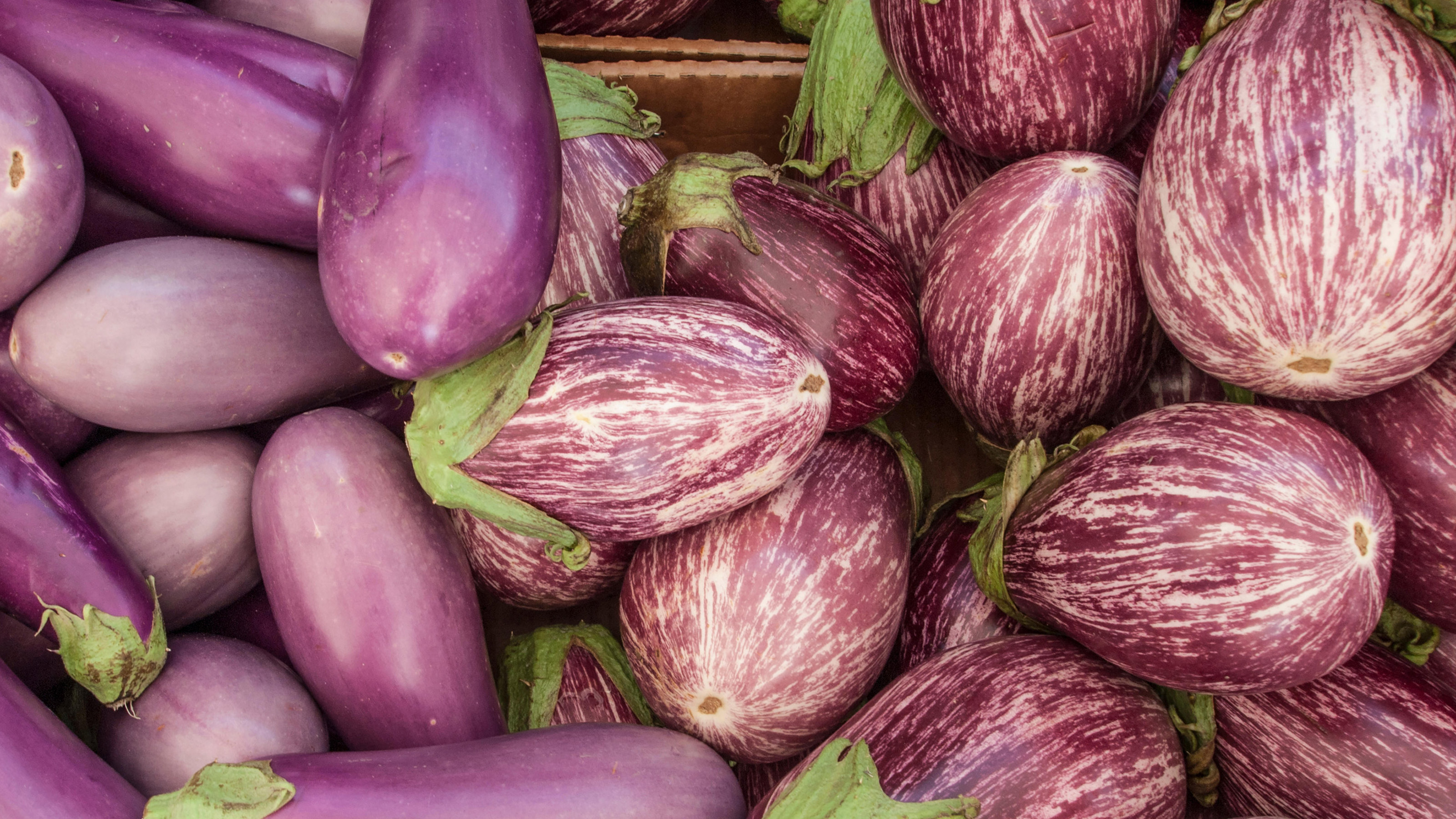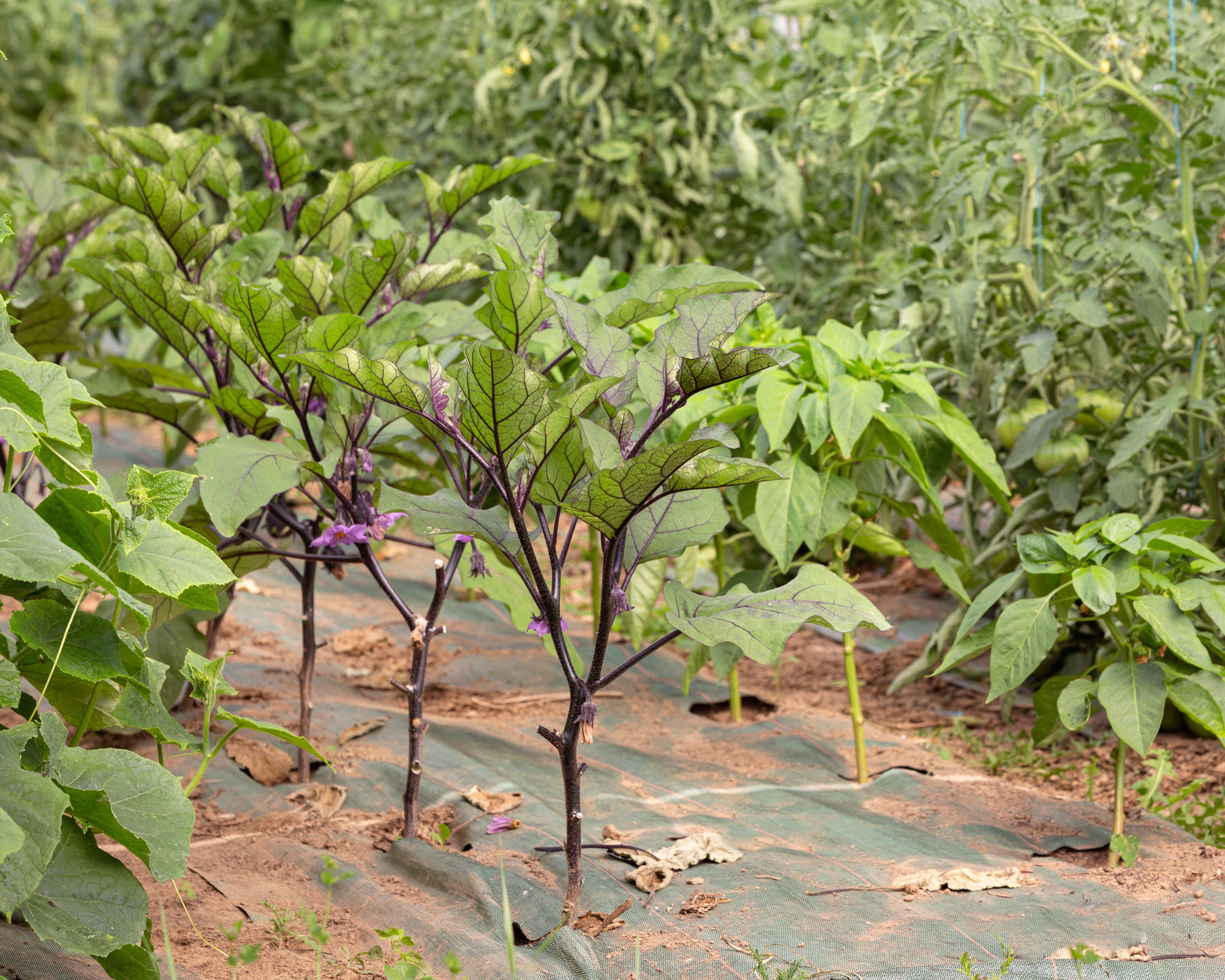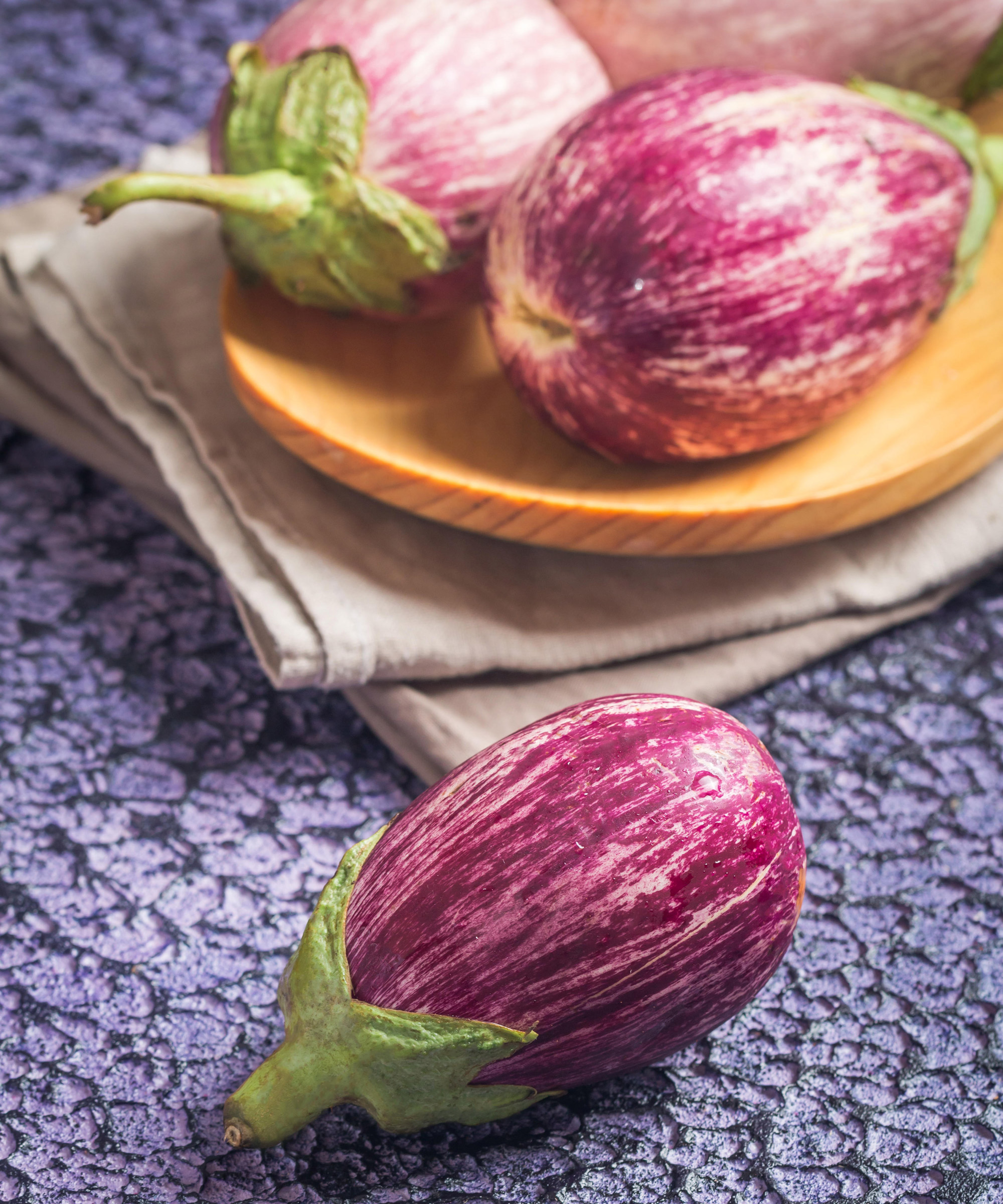How to grow eggplant: expert tips for growing aubergines
Find out how to grow eggplant and add some Mediterranean pizzazz to your kitchen garden


Knowing how to grow eggplant will take your veggie plot to a whole new level. Proud, glossy and full-bodied, the eggplant – or aubergine as it's called in some parts of the world – has captured the gardener’s imagination for centuries. Yet because of its semi-tropical credentials, it has a reputation for being fussy. This is a shame, for it is a surprisingly simple, enjoyable affair.
Eggplants (Solanum melongena) are easy to try, thanks to a proliferation of reliable varieties. Environmental factors are on your side, with greenhouses and polytunnels giving you more control. As long as your kitchen garden ideas involve plenty of warmth and sunshine, these fleshy, polished plantings are sure to romp to success.
Whether your tastes lean to classic fare or adventurous recipes, aubergines can cheer up any kitchen table. Big on substance and style – and low in fat and calories – this fleshy crop is a satisfying meat alternative for vegetarians and food lovers. Sliced or stuffed, grilled or stewed, it is a lively vehicle for flavor and texture in Mediterranean dishes like moussaka, baba ganoush, parmigiana and ratatouille.
Growing eggplants is a chance to broaden your horizons without breaking a sweat. Here we show you how to bring a touch of the exotic to your gardening with minimum fuss and maximum reward.
How to grow eggplant – where to start
The major considerations when learning how to grow eggplant are simple: sunshine and warmth, and lots of it. To give plants the best shot at success, you must also maintain moist conditions in the ground and regular balanced feeds: the eggplant is a hungry baby!
In order to regulate temperature, light and moisture, the aubergine is one of the best crops to plant in a greenhouse early in the year.
Sowing under glass gives you a cracking head start because these tender crops need a long growing season, as Amateur Gardening’s fruit and veg expert Lucy Chamberlain explains. ‘Being a tender veg, novices should treat the aubergine much like the tomato or chilli – all three come from the same plant family, after all! Sow early to give plants a long growing season and the best chance of a heavy, healthy crop.'

How to grow eggplant from seed, step by step
Remember, warmth and sunshine are crucial if you grow aubergines from seed. Germination is best in a warm greenhouse or heated propagator. However, a sunny conservatory or kitchen windowsill will do fine.
If you can’t grow eggplants in a propagator, cover pots in polythene. Secure with a band, and remove after germination. You need around eight-10 clear weeks before any attempt to move them outside.
1. Sow eggplant seeds indoors
Eggplant are deep-rooted crops and happiest started in small 3.5in (9cm) pots or modules. Using a good seed compost, sow under glass at 60-68˚F (15-20˚C). Top with vermiculite and water well. Keep them warm, then wait 10 days.
Remove lids or covers following germination. Prick out into individual pots when two true leaves appear – our guide on how to transplant seedlings has lots more tips for this.

2. Harden off your eggplant
When roots fill the pots, move into larger pots of free-draining compost. If you are moving crops outside, you must then harden them off for a week.
Unless you live in a mild climate, you can’t move aubergines and eggplants out until mid spring (typically mid May), when night temperatures hit 50˚F (10˚C), says Lucy Chamberlain. Use cloches or a fleece tent or create a windbreak to keep plants sheltered as they adjust.

3. Pot on and plant out your eggplant
If you don’t intend to grow aubergines on in large containers, you can now plant in greenhouse bedding or outdoors in raised garden beds or in the ground. Choose a warm, sunny, sheltered spot, preferably against a wall.
Check your soil type to make sure your site has a 6.3-6.8 pH, and fertilize. Plant in warm soil and space 2ft (60cm) apart. After planting, water well and add a layer of mulch. Cover with a cloche or fleece for two weeks.

What is the best month to plant eggplants?
Because these crops take their time bulking up, it’s important to start them off as soon as you can under glass. Even if you eventually grow eggplants outdoors in a raised garden bed or as part of your container gardening ideas, starting them under cover before spring gets going means you make the most of the growing season. Aubergines can take five months from sowing to harvest – so the sooner, the better.
Sow eggplant seeds in January or February, and you give crops ample time to build healthy root systems and fruit sets. But as Chris Bonnett of Gardening Express observes, it’s not enough to start early: you need to find a place with sunshine, and if you live in an area that experiences frosts, you need to keep young plants inside until the risk of frost passes.
Keeping plants in a heated greenhouse or a polytunnel gives the most control over the process, as crops benefit from extra growing times and steady temperatures. There are lots of tip on how to heat a greenhouse in our guide if you need extra advice on keeping your glasshouse warm.
You can keep potting on or plant in greenhouse beds in April. However, if you intend to plant out in May, you can delay indoor sowing until March.

How to care for eggplants
When learning how to grow eggplant, continued warmth is essential to healthy, tasty crops, so keep at around 68˚F (20˚C).
You also need to maintain generous levels of moisture. Make sure you are watering plants regularly. Depending on soil type and rainfall, give eggplants at least an inch of water a week, and more when they start fruiting. Humidity is also vital, so mist flowers with tepid water twice daily to help fruit set.
To encourage plants to fruit, gently tap or shake flowers (or use a small paint brush) to release the pollen. Once the first fruit starts to form, feed with a high-potash liquid plant food – and repeat at two-week intervals. Depending on the variety, remove further flowers once five or six fruits have formed; this means the plant can focus on nourishing larger crops.
Anyone looking to grow eggplants should also make time for mulching. This helps to retain soil moisture levels, whether you grow aubergines outside or in greenhouse beds. It also helps to suppress weed growth and keep soil temperatures steady.

How long does it take to grow an eggplant?
The time it takes to grow eggplants is often used as a reason not to bother – and we think this is a shame. All you need is a little patience, and you will be rewarded for your care and attention. Depending on the cultivar, fruits take two to three months to fully ripen from transplanting – that’s four-five months from sowing. If you start them early, you can harvest in August.
For some breeds, it can be a good idea to harvest before they reach full maturity, so check your instructions. For some types, the skins will have a glossy look (dull or wrinkled skins can indicate that they are past their best). Another way to check fruits are ready is to tap them, says Lucy Chamberlain. A thud indicates dense, plump fruit; a lighter, woody noise may mean they are over-ripe.
Cut (don’t pull) fruits with 0.7in (2cm) stalks using your best secateurs or a sharp knife. You can nudge along slower-ripening fruits by reducing the water you give plants or increasing warmth.

Do eggplants need a lot of sun?
One of the most important things to know when learning how to grow eggplant is that they crave light and warmth – so make sure your plants get a lot of sun.
Given the semi-tropical background of these sun-worshippers, it’s important to grow eggplant in full, steady sunshine and an ideal average temperature of 68-77˚F (20-25˚C). This warm season crop has its origins in the heat-soaked climes of Myanmar, Turkey and the Middle East. So as far as possible, you need to replicate the basic growing conditions that help plants flourish and yield the best fruits possible.
Start under glass in a heated greenhouse or polytunnel with plenty of sunlight. Do that, and these crops are some of the easiest vegetables to grow – as long as they grow in a moist, rich, well-drained base.
Make sure the compost or soil holds moisture, and keep adding water so plants don’t get parched. And make sure the ground stays warm. Juggling those needs is key to the success of growing eggplants.

Can I grow eggplant in pots?
While you can grow eggplants indoors with a view to planting in greenhouse beds or planting out when it gets sunnier, you do have another option. These plants are happy being kept in pots once they reach maturity. Indeed, for gardeners who enjoy growing vegetables in pots, eggplants are some of the most adaptable container crops you can try.
You can easily bring them to fruit in 9-10in (23-25cm) pots filled with a good potting compost and a little sand. Just keep the compost moist and well-fed, and make sure plants are well supported.
One of the great things about container growing is ease of movement. This kind of growing makes it possible for eggplants to flourish as part of your patio gardening ideas, but also means you can move plants back to the greenhouse if the weather takes a dip.
Experiment with different garden planters. Plastic tubs and containers are easy enough to move, but large terracotta pots keep the plants warmer, as Lucy Chamberlain explains: ‘The clay heats up well in the sun. These tender plants appreciate warm roots, plus the free drainage that terracotta brings.’ Just check the pot has drainage holes in the base.

Do eggplants need support to help them grow?
Whether you grow eggplants in garden borders, large containers or raised beds, the plants should be supported from an early stage. Staking makes all the difference, as the fruits can weigh the branches considerably. This support will also combat any extremes of weather. Depending on where you grow eggplants, you may find you can incorporate your growing plants into a number of different trellis ideas, ranging from standard planters and frames to more adventurous pole schemes.
Lucy Chamberlain suggests adding this support as soon as you can, shortly after planting out, to mitigate soil disturbance. This means staking with a sturdy bamboo cane before they set excess fruit and become top-heavy. Make sure the stakes are an inch or two from the plant. Keep an eye on the main stem and fasten it at regular intervals to the cane as it gets taller. If growing outdoors, factor in garden fences, pergola ideas or even cages as part of the overall support of the plant.
When plants are 1ft (30cm), pinch out tips to encourage side-shoots. This also promotes a bushier, more stable plant and helps produce fruit.

What should be planted near eggplants?
When growing eggplant, you will find they are not fussy. While they require plenty of sunshine, a nutrient-rich soil and regular watering, they aren’t very demanding. However, some clever companion planting can boost their health; deterring pests, attracting pollinators, helping with shade and offering a nutrient boost. The following are ideal partners:
- Peppers: As part of the Solanaceae family, eggplants make ideal companion plants for peppers and companion plants for tomatoes as they have similar requirements. Chris Bonnett notes: ‘Just check one doesn’t overshadow the other – sunlight is one thing these plants crave.’
- Legumes: These make ideal partners if you want to learn how to grow aubergines. Eggplants need a lot of nitrogen, and peas and beans add nitrogen into the ground – great news if you intend to grow French beans, for instance. Keep the eggplant at the front so it isn’t shaded.
- Potatoes: If you wish to grow potatoes with aubergines, you’re in luck, as potatoes can reduce pest issues. Eggplant is also happy growing with spinach, a cool-weather crop that benefits from being tucked away in the shade.
- Herbs: If you're already a fan of our herb garden ideas, the good news is that herbs make great companions as they are effective bug repellents. French tarragon wards off pests and thyme deters garden moths. Nasturtiums and marigolds are also effective pest controls.
As for plants to avoid, take care not to grow eggplants near sweet corn. This is because they will be competing for the same nutrients in the soil. Also avoid planting near geraniums, which are susceptible to leaf blight.

Potential eggplant growing problems
As activity ramps up in high summer, keep an eye out for unwanted guests in your kitchen garden. Pests can be a nuisance even with small vegetable garden ideas and particularly if you grow aubergines in the greenhouse. Stay vigilant for the following pests and act accordingly:
- Red spider mite If leaves get mottled or covered in webbing, this is a tell-tale sign. This pest thrives in dry conditions and contained environments, so mist plants regularly. Dishes of water between plants can help. Tackle pests with organic sprays.
- Aphids Look out for greenfly on shoot tips or leaves. These pests excrete a sticky honeydew, encouraging black sooty mould. A natural solution for how to get rid of aphids is to grow nasturtiums nearby as sacrificial plants. Squash aphids by hand, use an organic spray or try a biological control.
- Whitefly Check for small sap-sucking flies and sticky honeydew, which encourage sooty mould. Use biological controls or sticky traps.
It’s also important to get rid of weeds which can smother and steal essential goodness (and light). Don’t forget to remove old flower petals to prevent botrytis and mold which can spread to other parts of the plant.

How long do eggplants live for?
Once you've discovered how to grow eggplant, you will experience two things: weeks of eager anticipation waiting for those first fruits – then a sense that the glorious harvest is over far too soon!
As a general rule, eggplants are half-hardy annuals, which means they aren’t likely to last more than one winter. So the trick is to make the most of them while you have them – and make sure you squeeze every last fruit you can from your plants.
If you're growing eggplant in a greenhouse or mini greenhouse, make sure conditions are as warm as possible. To get the last fruits from plants, increase the temperature undercover, closing vents and adjusting blinds. Give ample space and factor in sensible greenhouse shelving ideas to keep plants healthy and happy for longer. Then, once the growing season is over in October, make plans to grow more varieties as soon as you can!
Are eggplants a fruit or vegetable?
People who grow eggplant often ask if they are fruits or vegetables. It’s the same debate we used to have about tomatoes, which is apt as the eggplant belongs to the same family. As part of the Solanaceae family, these crops are edible nightshades. In botanical terms the aubergine is a berry, like a blueberry or a melon. This is a head-scratcher, since they are all so diverse in shapes, textures and contents.
For those who know how to grow blueberries or how to grow watermelon, what you get when you grow eggplants is quite different. Furthermore, this unique crop (rich in potassium, magnesium and vitamins K, B6 and B1) isn’t consumed for sweetness. With its origins in India and China, it may look like a big shiny pear but its culinary clout is geared towards savory dishes.
That said, anyone with experience of growing tomatoes will find areas of overlap in terms of how you grow these fruits. And once you grow aubergines, you’ll delight at its versatility and how easy it is to cultivate.

Where to buy eggplant and aubergine seeds
If you’d like to try growing eggplant and aubergines, here are our suggestions for the best places to buy seeds. There’s a huge range available, with varieties tailored to indoor cultivation and container growing as well as outdoor planting. Use our quick links below for an easy way to start.
Where to buy eggplant seeds in the US:
- Shop eggplant seeds at Amazon
- Shop eggplant seeds at Burpee
- Shop eggplant seeds at Home Depot
- Shop eggplant seeds at Walmart
Where to buy aubergine seeds in the UK:

As assistant editor of Amateur Gardening magazine, Janey's gardening passion was fostered from an early age, when her amazing mum had her deadheading hydrangeas, mulching roses, and propagating strawberry plants from runners for school open days. She's also taken part in lots of conservation and rewilding projects for the RHS and TCV as a way of exploring her horticultural horizons.
